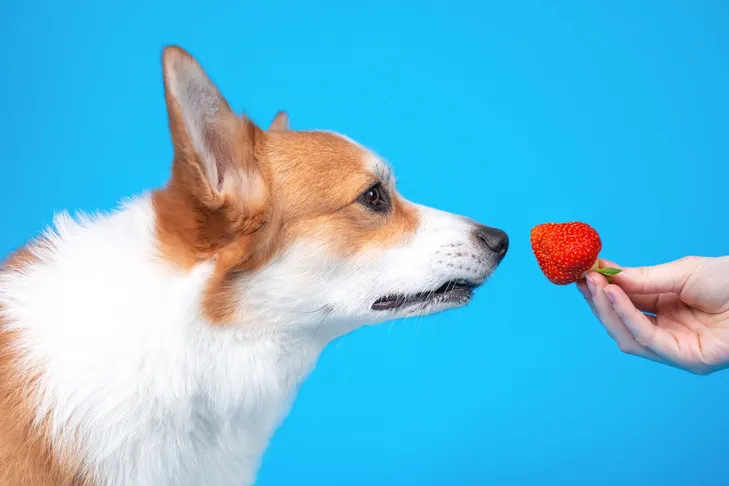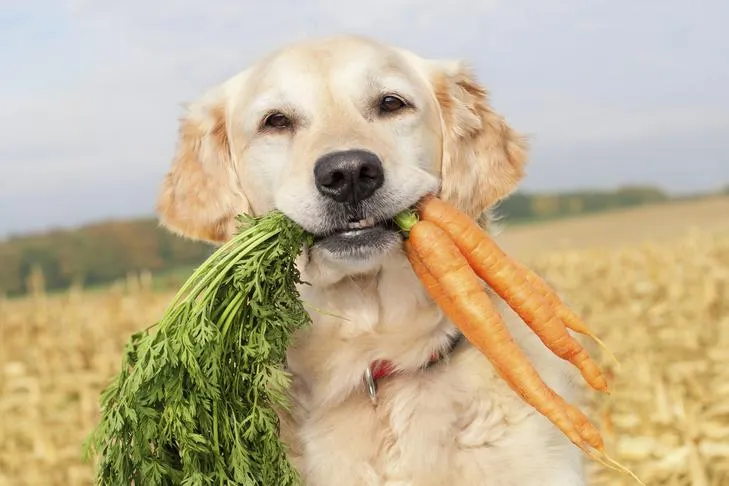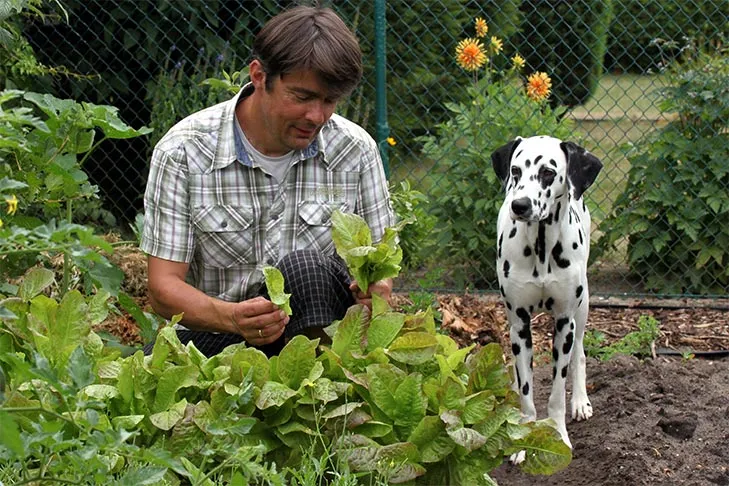It’s natural to want to share your favorite snacks with your beloved canine companion. After all, if a food item is safe and healthy for you, it must be acceptable for your dog, right? Not necessarily. While many human foods can be harmless and even beneficial for dogs in moderation, others are downright dangerous, potentially leading to severe health issues or worse. Understanding the distinct digestive systems of dogs compared to humans is crucial. This comprehensive guide will help you navigate the world of fruits and vegetables, highlighting what vegetables you should not feed a dog, along with other fruits and vegetables that pose risks, and which ones are safe to share as occasional treats. Knowing these distinctions is vital for every dog owner dedicated to their pet’s health and well-being. To ensure you’re providing the best for your furry friend, it’s essential to be informed about what human food can dogs eat and not eat.
Understanding Your Dog’s Dietary Needs
Dogs are omnivores, meaning their natural diet includes both meat and plant matter. However, this doesn’t mean they can safely consume all the same fruits and vegetables as humans. Their digestive tracts are different, and certain compounds that are harmless to us can be toxic to them. While fruits and vegetables are not a primary component of a dog’s diet, they can offer valuable vitamins, minerals, and fiber when given appropriately. Always introduce new foods slowly and in small quantities to observe any adverse reactions. When considering any significant dietary changes or concerns, consulting with your veterinarian is always the best course of action to ensure your dog’s nutritional needs are met safely and effectively.
Fruits Dogs Can Eat (In Moderation)
Many fruits offer a healthy, delicious treat option for dogs, providing essential vitamins, minerals, and antioxidants. Remember to always wash fruits thoroughly and remove any pits, seeds, or tough skins before offering them to your dog.
Apples
Apples are a fantastic source of vitamins A and C, and dietary fiber, making them an ideal low-protein, low-fat snack, especially beneficial for senior dogs. Always remove the seeds and core, as apple seeds contain small amounts of cyanide. For a refreshing treat, try them frozen.
Bananas
Rich in potassium, vitamins, biotin, fiber, and copper, bananas are a low-calorie treat for dogs when given in moderation. Their high sugar content means they should be an occasional treat, not a staple. They’re a great option for a quick energy boost.
Blueberries
Often called a superfood, blueberries are packed with antioxidants that can help prevent cell damage. They are also rich in fiber and phytochemicals. Small, round, and easy to handle, they can even be used as a fun training reward.
Cantaloupe
This hydrating melon is loaded with nutrients, low in calories, and a good source of water and fiber. Due to its high sugar content, cantaloupe should be offered sparingly, especially to dogs who are overweight or have diabetes. Frozen cantaloupe cubes make an excellent summer enrichment snack.
Cranberries
Both fresh and dried cranberries are safe for dogs in small amounts. While their tartness might not appeal to every dog, they offer antioxidants. It’s crucial to avoid sweetened dried cranberries, as the added sugar is unnecessary and unhealthy for dogs. Opt for unsweetened varieties or look for dog treats that naturally incorporate cranberries.
Cucumbers
Cucumbers are an excellent choice for dogs, particularly those needing to watch their weight, as they contain very few carbohydrates or fats and are highly hydrating. They are rich in vitamins K, C, and B1, along with potassium, copper, magnesium, and biotin. Sliced and chilled, they make a crisp, refreshing treat.
 A Russell Terrier with refreshing cucumber slices, highlighting safe vegetables for dogs.
A Russell Terrier with refreshing cucumber slices, highlighting safe vegetables for dogs.
Mango
This sweet, tropical fruit is a powerhouse of vitamins A, B6, C, and E, as well as potassium and both beta-carotene and alpha-carotene. As with peaches, the hard pit of a mango must be removed completely, as it contains small amounts of cyanide and poses a choking hazard. Due to its sugar content, mango should be an occasional treat.
Oranges
Veterinarians generally consider oranges safe for dogs, though their strong citrus scent and taste often deter canines. They are an excellent source of vitamin C, potassium, and fiber. Only offer the juicy flesh in small quantities, peeled and deseeded, as the peel can be tough on their digestive system and contains oils that some dogs find irritating.
Peaches
Fresh or frozen peach slices, with the pit completely removed, are a good source of fiber and vitamin A. Like cherries, peach pits contain cyanide and must be safely discarded to prevent ingestion. Canned peaches, often loaded with sugary syrups, should be avoided entirely. Frozen peach slices can be a delightful, cooling treat.
 A Siberian Husky puppy near an apple tree, reminding pet owners to remove seeds and core before sharing safe fruits.
A Siberian Husky puppy near an apple tree, reminding pet owners to remove seeds and core before sharing safe fruits.
Pears
Pears are a nutritious snack, high in copper, vitamins C and K, and fiber. Always cut them into bite-sized pieces and remove the core and seeds, as pear seeds contain traces of cyanide. Avoid canned pears with added syrups.
Pineapple
A few chunks of fresh pineapple, with the prickly peel and crown removed, offer a sweet treat rich in vitamins, minerals, and fiber. Pineapple also contains bromelain, an enzyme that aids protein absorption. As with other fruits, skip sweetened canned or packaged pineapple.
Pumpkin
Pure pumpkin is a highly beneficial food for dogs, revered for its digestive health properties. It’s rich in antioxidants and uniquely effective at relieving both diarrhea and constipation. When buying canned pumpkin, ensure it’s 100% pumpkin puree, not pie filling, which contains spices and sugar. You can also roast and peel fresh pumpkin.
Raspberries
Raspberries are safe for dogs in moderation and offer a wealth of antioxidants. They are low in sugar and calories but high in fiber, manganese, and vitamin C. Their anti-inflammatory properties make them particularly good for senior dogs struggling with aging joints. However, raspberries contain small, naturally occurring amounts of xylitol, so limit your dog to no more than 8 ounces of fresh or frozen raspberries to be safe.
Strawberries
Packed with fiber and vitamin C, strawberries also contain an enzyme that can help whiten your dog’s teeth. Like all fruits, their natural sugar content means moderation is key. Frozen strawberries are a fun enrichment treat.
 A Pembroke Welsh Corgi sniffing a fresh strawberry, a safe fruit for dogs in moderation.
A Pembroke Welsh Corgi sniffing a fresh strawberry, a safe fruit for dogs in moderation.
Watermelon
Watermelon is a hydrating treat, rich in vitamins A, B-6, and C, as well as potassium. It’s 92% water, making it perfect for hot summer days. However, the rind and seeds must be completely removed to prevent intestinal blockage. Freeze chunks of seeded watermelon for a refreshing snack.
Fruits Dogs Should Avoid (Toxic & Dangerous)
While some fruits are staples in human diets, they can contain toxic compounds or parts that are dangerous for dogs. It’s best to keep these fruits out of your dog’s reach entirely to ensure their safety.
Avocado
Avocado, a superfood for humans, should not be given to dogs. The pit, skin, and leaves contain persin, a toxin that can cause vomiting and diarrhea in dogs. While the fleshy part has less persin, it can still be too much for a dog’s sensitive system. Furthermore, avocado flesh is high in fat, which can lead to gastrointestinal upset and, in severe cases, pancreatitis. If you’re looking for what are good things for dogs to eat, avocado is not one of them.
Cherries
With the exception of the sweet fleshy fruit around the seed, all parts of the cherry plant (leaves, stems, and especially the pits) contain cyanide, which is highly toxic to dogs. Cyanide interferes with cellular oxygen transport, meaning a dog’s blood cells can’t get enough oxygen. If your dog consumes cherries whole or just the pits, watch for signs of cyanide poisoning, such as dilated pupils, difficulty breathing, and red gums, and seek immediate veterinary attention. Always ensure cherry pits are securely disposed of.
Grapes
Grapes and raisins are notoriously toxic to dogs, regardless of breed, age, or sex. Even small amounts can lead to acute sudden kidney failure. This makes them one of the most dangerous human foods for dogs. Always be extremely vigilant, especially if you have children who eat grapes or raisins, and ensure they are stored in dog-proof containers or out of reach.
Tomatoes
While the ripened red flesh of a tomato is generally considered safe for dogs, the green parts of the tomato plant—stems, leaves, and unripe green tomatoes—contain solanine, a toxic substance. A dog would need to ingest a significant amount to become gravely ill, but it’s safest to avoid offering tomatoes altogether. If you have a vegetable garden, ensure your dog cannot access tomato plants.
 A curious Rottweiler resting in a garden, emphasizing the importance of knowing what vegetables to avoid feeding a dog.
A curious Rottweiler resting in a garden, emphasizing the importance of knowing what vegetables to avoid feeding a dog.
Safe Vegetables for Dogs: Healthy Additions to Their Diet
Understanding which vegetables are safe and beneficial is just as important as knowing what vegetables you should not feed a dog. Many vegetables offer valuable nutrients and can be a healthy, low-calorie treat for your dog.
Broccoli
Broccoli can be safe for dogs in small quantities as an occasional treat. It’s rich in fiber and vitamin C and low in fat. However, the florets contain isothiocyanates, which can cause mild to severe gastric irritation in some dogs. The tough stalks also pose a potential choking hazard or obstruction risk. If you choose to offer broccoli, it’s best to serve it cooked and in very small, manageable pieces to minimize risks.
Brussels Sprouts
Brussels sprouts are packed with beneficial nutrients and antioxidants for both humans and dogs. However, their high sulfur content means overfeeding them can lead to excessive gas and digestive upset in dogs. Offer them sparingly and cooked.
Carrots
Carrots are an excellent low-calorie snack, high in fiber and beta-carotene (which converts to vitamin A). The crunchy texture is also great for your dog’s dental health, helping to clean teeth naturally. They are a common ingredient in many commercial dog foods and treats.
 A happy Golden Retriever holding carrots, a healthy and safe vegetable snack for dogs.
A happy Golden Retriever holding carrots, a healthy and safe vegetable snack for dogs.
Celery
Celery provides vitamins A, B, and C, along with nutrients that can support heart health and potentially help fight cancer. An added bonus: celery is also known to help freshen doggy breath! Cut it into small, chewable pieces to prevent choking.
Green Beans
Chopped, steamed, raw, or canned (plain, no-salt-added varieties) – green beans are safe for dogs. They are full of essential vitamins, minerals, and fiber, and are very low in calories, making them a great filler for dogs on a diet. Frozen green beans can also be a fun, crunchy snack.
Peas
Green peas, snow peas, sugar snap peas, and garden peas are all acceptable for dogs occasionally. They are rich in vitamins, minerals, protein, and fiber. You can offer fresh or frozen peas, but always avoid canned peas with added sodium, which can be harmful.
Spinach
While dogs can technically eat spinach, it’s not the top recommendation due to its high oxalic acid content. Oxalic acid can interfere with calcium absorption and, in very large quantities, may contribute to kidney damage. Although a dog would likely need to consume a substantial amount for this to be an issue, many other vegetables offer more straightforward benefits. If you wish to give spinach, do so sparingly.
 A curious Dalmatian observing gardening, a reminder to secure garden produce and understand which vegetables dogs should not eat.
A curious Dalmatian observing gardening, a reminder to secure garden produce and understand which vegetables dogs should not eat.
What Vegetables Should You Not Feed a Dog? A Critical List
It’s paramount for every dog owner to be aware of the specific vegetables that are harmful or even toxic to their canine companions. Understanding this critical list ensures you can protect your pet from accidental ingestion and related health issues.
Asparagus
Asparagus isn’t necessarily toxic to dogs, but it offers little to no nutritional benefit that outweighs its potential downsides. It’s too tough to be eaten raw, and by the time it’s cooked soft enough for a dog to safely consume, most of its nutritional value is lost. Given the many other healthier and safer vegetable options available, asparagus is generally considered an unnecessary food for dogs.
Mushrooms
Wild mushrooms are a significant danger to dogs. While only a small percentage of mushroom species are toxic, the poisonous ones can cause severe illness, liver failure, or even death. It’s incredibly difficult for an untrained eye to distinguish between safe and toxic varieties. Therefore, it is strongly advised to prevent your dog from eating any wild mushrooms. Washed mushrooms purchased from a supermarket, intended for human consumption, are generally safe for dogs in small amounts, but due to the high risk associated with wild varieties, many owners choose to avoid mushrooms entirely.
Onions
Onions are perhaps the most crucial item on the list of what vegetables you should not feed a dog. Along with leeks, chives, and garlic, onions belong to the Allium family, which is poisonous to most pets, especially cats and certain dog breeds like Akitas and Shiba Inus. Ingestion of onions can cause your dog’s red blood cells to rupture, leading to anemia. Symptoms can include vomiting, diarrhea, stomach pain, lethargy, and pale gums. The effects can be cumulative, meaning even small, repeated exposures can lead to poisoning over time. Always secure foods containing onions and educate household members, especially children, about this danger. For those wondering what should a 4 month puppy eat, onions are definitely not part of the recommended diet.
What to Do If Your Dog Eats a Toxic Food
Despite our best efforts, accidents can happen. If you suspect your dog has eaten a toxic fruit or vegetable, immediate action is crucial.
- Stay Calm and Act Quickly: Panic can make it harder to think clearly.
- Contact Your Veterinarian or an Emergency Animal Hospital Immediately: Provide them with as much information as possible: what your dog ate, approximately how much, when they ate it, and any symptoms you’ve observed.
- Do Not Induce Vomiting Unless Instructed: Some toxins can cause more damage coming back up. Only induce vomiting if a veterinarian explicitly tells you to do so and guides you on the method.
- Monitor Your Dog for Symptoms: Be aware of signs like vomiting, diarrhea, lethargy, weakness, excessive drooling, difficulty breathing, tremors, seizures, or changes in gum color.
- Bring a Sample (if possible): If you’re unsure what your dog ate, bringing a sample of the plant or food to the vet can help with identification.
Prevention is always the best approach. Keeping harmful foods out of reach, securing trash cans, and educating everyone in your household about safe and unsafe foods are key steps to protecting your dog. Beyond fruits and vegetables, understanding other safe treats like certain what bones can i feed my dog or appropriate what raw meat can i feed my pitbull is also crucial for a balanced and safe diet.
Conclusion
Navigating the world of human foods for dogs can feel overwhelming, but being informed is the first step towards ensuring your canine companion’s health and happiness. While many fruits and vegetables offer valuable nutrients and make excellent treats in moderation, knowing what vegetables you should not feed a dog – alongside other toxic fruits like grapes and avocados – is absolutely critical. Always remember to prepare safe fruits and vegetables correctly, removing seeds, pits, and rinds, and introduce new foods slowly. When in doubt, it’s always best to err on the side of caution and consult your veterinarian. Your vigilance and commitment to providing a safe and healthy diet will ensure your furry friend lives a long, happy, and vibrant life. Stay informed to keep your dog healthy and happy!
